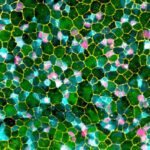Lien vers Pubmed [PMID] – 27693369
Dev. Biol. 2016 Dec;420(1):120-135
Neurogenesis in the post-embryonic vertebrate brain varies in extent and efficiency between species and brain territories. Distinct neurogenesis modes may account for this diversity, and several neural progenitor subtypes, radial glial cells (RG) and neuroepithelial progenitors (NE), have been identified in the adult zebrafish brain. The neurogenic sequences issued from these progenitors, and their contribution to brain construction, remain incompletely understood. Here we use genetic tracing techniques based on conditional Cre recombination and Tet-On neuronal birthdating to unravel the neurogenic sequence operating from NE progenitors in the zebrafish post-embryonic optic tectum. We reveal that a subpopulation of her5-positive NE cells of the posterior midbrain layer stands at the top of a neurogenic hierarchy involving, in order, the amplification pool of the tectal proliferation zone (TPZ), followed by her4-positive RG cells with transient neurogenic activity. We further demonstrate that the adult her5-positive NE pool is issued in lineage from an identically located NE pool expressing the same gene in the embryonic neural tube. Finally, we show that these features are reminiscent of the neurogenic sequence and embryonic origin of the her9-positive progenitor NE pool involved in the construction of the lateral pallium at post-embryonic stages. Together, our results highlight the shared recruitment of an identical neurogenic strategy by two remote brain territories, where long-lasting NE pools serve both as a growth zone and as the life-long source of young neurogenic RG cells.

